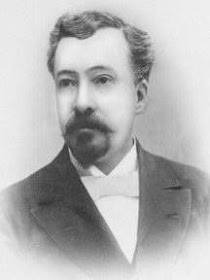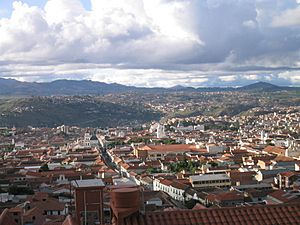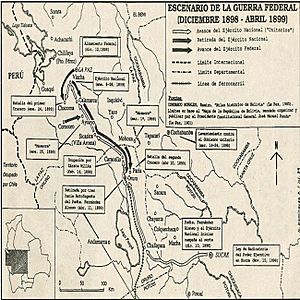Severo Fernández facts for kids
Quick facts for kids
Severo Fernández
|
|||||||||||||||||||||||||||||||||||||||||
|---|---|---|---|---|---|---|---|---|---|---|---|---|---|---|---|---|---|---|---|---|---|---|---|---|---|---|---|---|---|---|---|---|---|---|---|---|---|---|---|---|---|

Photograph of Severo Fernández in 1898.
|
|||||||||||||||||||||||||||||||||||||||||
| 24th President of Bolivia | |||||||||||||||||||||||||||||||||||||||||
| In office 19 August 1896 – 12 April 1899 |
|||||||||||||||||||||||||||||||||||||||||
| Vice President | Rafael Peña de Flores Jenaro Sanjinés |
||||||||||||||||||||||||||||||||||||||||
| Preceded by | Mariano Baptista | ||||||||||||||||||||||||||||||||||||||||
| Succeeded by | José Manuel Pando | ||||||||||||||||||||||||||||||||||||||||
| 10th Vice President of Bolivia | |||||||||||||||||||||||||||||||||||||||||
|
First Vice President
|
|||||||||||||||||||||||||||||||||||||||||
| In office 11 August 1892 – 19 August 1896 |
|||||||||||||||||||||||||||||||||||||||||
| President | Mariano Baptista | ||||||||||||||||||||||||||||||||||||||||
| Preceded by | José Manuel del Carpio | ||||||||||||||||||||||||||||||||||||||||
| Succeeded by | Rafael Peña de Flores | ||||||||||||||||||||||||||||||||||||||||
|
|||||||||||||||||||||||||||||||||||||||||
| Personal details | |||||||||||||||||||||||||||||||||||||||||
| Born |
Severo Fernández Alonso Caballero
15 August 1849 Sucre, Bolivia |
||||||||||||||||||||||||||||||||||||||||
| Died | 12 August 1925 (aged 75) Potosí, Bolivia |
||||||||||||||||||||||||||||||||||||||||
| Political party | Conservative | ||||||||||||||||||||||||||||||||||||||||
| Spouse | Filomena Perusqui Aramayo | ||||||||||||||||||||||||||||||||||||||||
| Parents | Ángel Fernández Casimira Caballero |
||||||||||||||||||||||||||||||||||||||||
| Education | University of Saint Francis Xavier | ||||||||||||||||||||||||||||||||||||||||
| Signature |  |
||||||||||||||||||||||||||||||||||||||||
Severo Fernández Alonso Caballero (born August 15, 1849, in Sucre – died August 12, 1925) was an important Bolivian lawyer and politician. He served as the 24th president of Bolivia from 1896 to 1899. Before that, he was the tenth vice president of Bolivia from 1892 to 1896. He is known as the last president from the Conservative Party during a time when they were very powerful in Bolivia (1884–1899).
Contents
Severo Fernández's Early Life & Career
Severo Fernández was the son of Ángel Fernández and Casimira Caballero. He studied law at the Universidad Mayor, Real y Pontificia de San Francisco Xavier de Chuquisaca. After finishing his studies, he became a successful lawyer. He worked with large mining companies and earned a lot of money. He was especially connected to rich silver mine owners like Gregorio Pacheco and Aniceto Arce.
He also worked as a journalist for newspapers like El Regime Legal and El País de Sucre. He was known for his excellent writing skills. In politics, he served as a minister in different governments. He was the Minister of the Interior for President Aniceto Arce. Later, he became the Minister of War for President Mariano Baptista. He also served as the Vice President under Baptista and led the National Congress.
Becoming President of Bolivia
How Severo Fernández Won the Election
Severo Fernández was a member of the Conservative Party. He won the 1896 general elections, beating the Liberal Party. He became president on August 28, 1896, when he was 47 years old. The Liberal Party was not happy with the election results and often opposed his government. They felt that the Conservatives had been in power for too long, sometimes winning elections unfairly.
What Severo Fernández Did as President
During his time as president, several important things happened:
- An engineering school was started in Sucre.
- Work began on the first telegraph line to the eastern part of the country.
- A suspension bridge was built over the Pilcomayo River.
- The Government Palace in Sucre was completed.
- A new port called Puerto Alonso was founded.
During his presidency, the city of La Paz grew more and more important. The Liberal Party had a lot of support there. By 1898, only the mining cities of Sucre and Potosí remained strongly loyal to the Conservative government.
The Bolivian Civil War (1898-1899)
Why the War Started: The Capital City Debate
For many years, there was a big debate about which city should be the official capital of Bolivia. Sucre had been considered the capital since the country's early days. However, by the 1880s, conservative presidents often stayed in Sucre, making it the de facto (unofficial) capital. La Paz, on the other hand, was growing quickly and becoming a powerful city.
On October 31, 1898, lawmakers from Sucre suggested a "Radicatory Law." This law would officially make Sucre the permanent capital and the seat of the government. Lawmakers from La Paz disagreed. They wanted Congress to move to a neutral city like Cochabamba, but this idea was rejected.
The Liberal Party, led by José Manuel Pando, saw an opportunity. They pretended to agree with the "Radicatory Law" at first. But their real plan was to get the people and soldiers in La Paz to rise up if the law passed.
The Uprising in La Paz
On November 6, 1898, a large protest happened in La Paz. People demanded that their city become the capital and that the country adopt a "federal" system (where power is shared more evenly). On November 14, a Federal Committee was created, led by Colonel Pando.
Three days later, the "Radicatory Law" was approved, making Sucre the official capital. President Fernández officially announced it on November 19. In response, on December 12, the people of La Paz supported the formation of a Federal Board. This board included Liberals and some officials who switched sides. Colonel Pando's Liberals also allied with Pablo Zárate Willka, a leader of the indigenous people in the Altiplano region.
The War Begins
After these events, the lawmakers from La Paz left Congress and returned home. The people of La Paz welcomed them with cheers. Overthrowing President Fernández became the main goal of the federalists. In contrast, people in Sucre held protests to support the government.
President Fernández decided to march to La Paz with his soldiers. In a place called Challapata, he learned that the rebels had many weapons. He asked for volunteers in Sucre to join his army. Two brigades were formed, including young men from both wealthy and working-class families. However, as the government forces marched, they took supplies from indigenous villages in the countryside.
The government's first group of soldiers met Pando's forces in Cosmini. They were forced to hide in a church in Ayo Ayo. On January 24, 1899, they were attacked and many were killed. In Potosí, people openly refused to help the government. In Santa Cruz and Tarija, people remained neutral. Meanwhile, indigenous communities in Cochabamba, Oruro, La Paz, and Potosí started their own uprisings to support the Liberals.
The most important battle of the war was the Battle of Segundo Crucero on April 10, 1899. President Fernández's troops fought against Pando's forces for four hours. Pando's troops won the battle. The defeated government forces went to Oruro, and soon after, President Fernández left the country.
Life After the Presidency
Severo Fernández went to Chile and lived there for several years. He returned to Bolivia later, during the government of Eliodoro Villazón. He was appointed as a special minister to Peru and Argentina. In 1914, he became a judge in the Supreme Court of Justice and later its president. Finally, in 1922, he was elected as a Senator for the Chuquisaca region and became the president of the National Congress. He passed away on August 12, 1925.
Severo Fernández's Impact
Severo Fernández was the last president from the Conservative Party during their long period of power. The growing importance of La Paz, a city controlled by the Liberals, and the fight over the capital's location eventually weakened the Conservative Party, whose main support was in Sucre. Even today, La Paz remains the most important city in Bolivia.
A town called Puerto Fernández Alonso is named after him.
Images for kids
See also
 In Spanish: Severo Fernández Alonso Caballero para niños
In Spanish: Severo Fernández Alonso Caballero para niños




